Knowing the password for a Wi-Fi network you’ve previously connected to can be a lifesaver when you need to share it with friends or colleagues. Whether you have a stock Android device or a Samsung Galaxy, there are a few methods to find these passwords. In this article, we’ll explore how to view the passwords for Wi-Fi networks on various Android devices, from Android 4.4 to Android 13, on both rooted and non-rooted devices.
Method 1: Stock Android 10 to Android 13
This method is the easiest for stock Android 10, Android 11, Android 12, and Android 13 devices. No root access is required, and it doesn’t even need an additional app.
Devices That Support This Method
Google’s Pixel devices, such as the Pixel 4 and newer models, support Android 13, the latest operating system update. Although the Android One program is no longer available, manufacturers like LG, Nokia, Motorola, and Xiaomi are still bound by Google’s requirements to provide software updates for at least two years following the device’s release. Phones such as the Nokia X10 and X20 support Android 13, but others released in 2020 or 2021 will likely max out at Android 12.
Quick Steps
- Open the Wi-Fi or Internet submenu in Settings.
- Tap the current network or select “Saved networks” and choose one.
- Tap “Share” below the network’s name.
- Authenticate yourself if you have device security set up.
- See the plain text password under the QR code.
Full Instructions
First, locate the “Wi-Fi” submenu in your Settings app. Depending on your phone model and software, you can find it using one of these methods:
- Search for “wifi” in Settings, then tap the “Wi-Fi” result.
- Ask Google Assistant to “open Wi-Fi settings.”
- Long-press the Wi-Fi symbol in the Quick Settings.
- Go to Settings -> Network & internet -> Internet.
- Go to Settings -> Network & internet -> Wi-Fi.
- Go to Settings -> Wi-Fi (on Android 11 only).
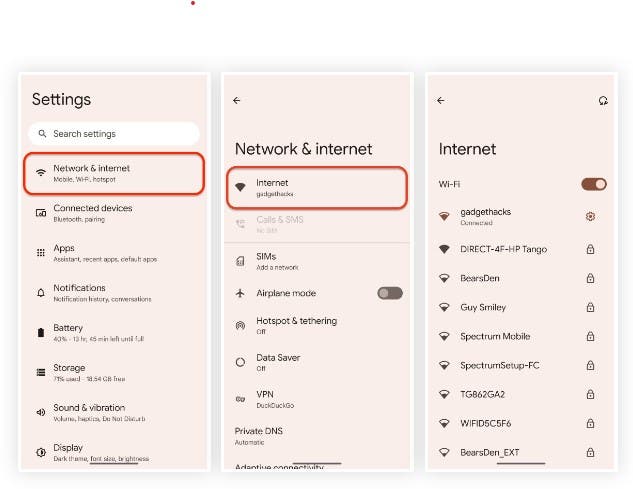
On the Wi-Fi or Internet settings page, tap the network up top that you’re currently connected to if that’s the one you need the password for. Otherwise, scroll down and select the “Saved networks” option. On the saved list, choose the Wi-Fi network you need the password for.
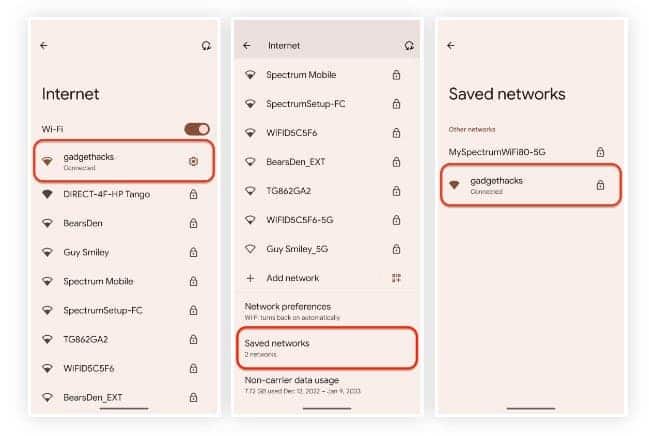
Now, hit the “Share” option below the network name and status. It will ask you to scan your fingerprint, scan your face, enter your PIN, or enter your password if you have security set up. Below the QR code storing the network’s credentials, you’ll see the password in plain text.
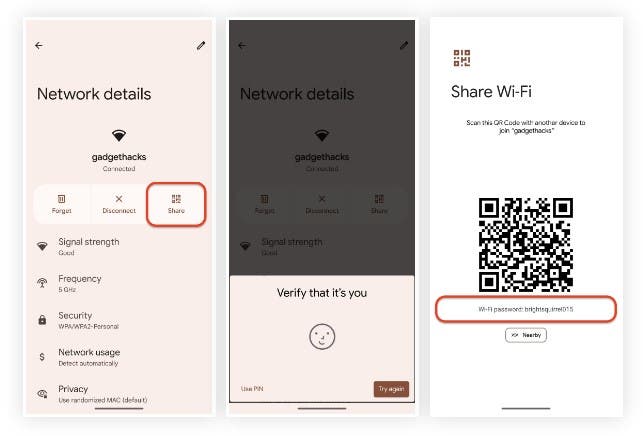
Method 2: Android 10 to Android 13 on Samsung Galaxy Devices
Samsung devices use a skin called One UI on top of the basic Android system, with One UI 5.1 for Android 13 being the newest version. Many elements look and behave differently than on a Google Pixel, including getting plain text passwords for saved Wi-Fi networks.
Quick Steps
- Open the “Connections” menu in Settings.
- Tap on the “Wi-Fi” submenu.
- Tap the cog for the current network.
- Tap “QR code.”
- Tap “Save as image” to save it to your gallery.
- Open Google Lens or open the image in Google Photos.
- Open the image in Google Lens or tap the Lens icon in Google Photos.
- Expand the crop beyond the QR code’s perimeter if needed.
- See the plain text password in the results.
Full Instructions
First, visit the “Wi-Fi” submenu in your Settings app. You can:
- Ask Bixby to “open Wi-Fi settings.”
- Ask Google Assistant (if installed) to “open Wi-Fi settings.”
- Long-press the Wi-Fi symbol in the Quick Settings.
- Search for “wifi” in Settings, then tap the “Wi-Fi” result. If it doesn’t take you directly to the Wi-Fi submenu, tap “Wi-Fi” in the Connections menu.
- Go to Settings -> Connections -> Wi-Fi.
Once in the Wi-Fi submenu, tap the cog next to the network SSID (service set identifier), more commonly referred to as the network name, that you’re currently connected to.
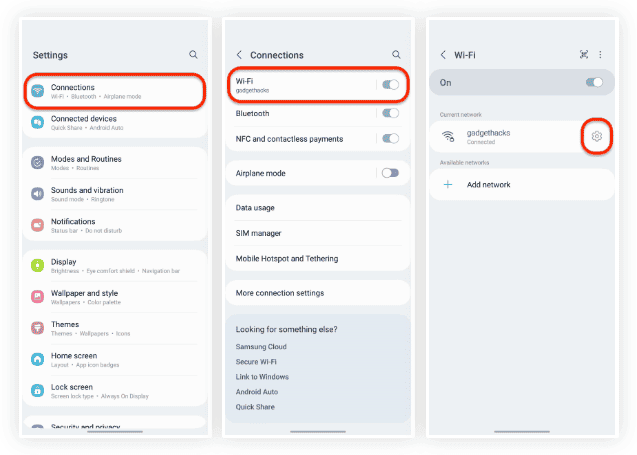
Next, select “QR code” at the bottom of the network’s information. You can only get the QR code for the network you’re connected to, which is the biggest difference between One UI and stock Android. Another significant difference is that you won’t see the network’s password in plain text. You also can’t ask Bixby for it.
Save image to the gallery
On the QR code page, hit “Save as image” to add it to your gallery.
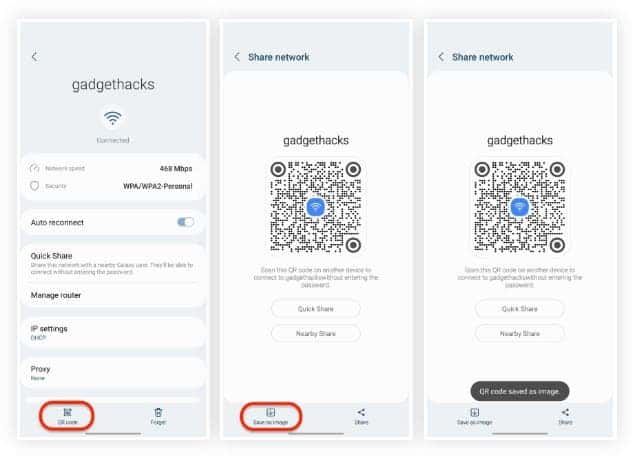
Next, use Google Lens to scan the saved image. You can do this in various ways:
- Open Google Photos (if installed), select the image, and hit the “Lens” button.
- Tap the camera button on the Google app’s home screen widget (if installed), then select the saved image. You may need to tap the gallery icon in the corner before you can select the image.
- Open the Google app (if installed), tap the camera icon in the search bar, then select the saved image. You may need to tap the gallery icon in the corner before you can select the image.
- Open the Google Lens app (if installed), then select the saved image. You may need to tap the gallery icon in the corner before you can select the image.
Either way, if it’s the first time using Google Lens for photos, you’ll have to give it permission to access your gallery. Hit “Allow access,” then “Allow” on the next prompt.
Google Lens will start scanning the image, and it may end up focusing on everything inside the QR code’s perimeter, which won’t show you what you need. If that’s the case, manually expand the crop on the image to go past the QR code’s perimeter.
When it successfully reads the QR code, it will show the network credentials in plain text, including the password, below the picture.
Method 3: Android 6 to Android 9 on Non-Rooted Devices
Most phones and tablets running stock or skinned Android 9 and earlier cannot generate QR codes with a Wi-Fi network’s credentials embedded. There are apps that help you create QR codes for Wi-Fi hotspots, but you need to know the password, which isn’t any help if you don’t know it.
On Android 9 and earlier, the file containing saved Wi-Fi credentials is in a protected directory, and you can only access it if you’re rooted (see Method 4 below). However, if you have received a QR code for a Wi-Fi access point from another device, you can use the Google Lens app or Lens in Google Photos to scan the QR code for the password.
Quick Steps for Google Lens:
- Open the Google Lens app or tap the Lens icon in the Google app or Google app’s home screen widget.
- Select the image from your gallery or choose “Search with your camera.”
- If using the camera, point it at the QR code and tap the shutter button.
- Expand the crop beyond the QR code’s perimeter if needed.
- Pull up the results to see the plain text password.
Quick Steps for Google Photos:
- Open the Google Photos app.
- Select the image from your gallery.
- Tap “Lens” on the image.
- Expand the crop beyond the QR code’s perimeter if needed.
- Pull up the results to see the plain text password.
Full Instructions
First, open either Google Lens or Google Photos. For Google Lens, you can open its app directly or tap the Lens icon on the Google app’s home screen widget or from within the Google app itself.
Next, select the image with the QR code from your gallery. In the Google Lens app, you can also choose “Search with your camera” if the QR code is printed out or on another device; if so, scan the code with your camera. On Google Photos, tap the “Lens” button once you load the image.
Google Lens will start scanning the image, and it may end up focusing on everything inside the QR code’s perimeter, which won’t show you what you need. If that’s the case, manually expand the crop on the image to go past the QR code’s perimeter.
When it successfully reads the QR code, it will show the network credentials in plain text, including the password, on the card (pull up on it to see the details).
Method 4: Android 4.4 to Android 9 on Rooted Devices
If your phone is running Android 9.0 Pie or lower and you want to view the passwords for your saved Wi-Fi networks, the only way to do so is with a root app. It will work best if you have TWRP installed and used that to install Magisk for root.
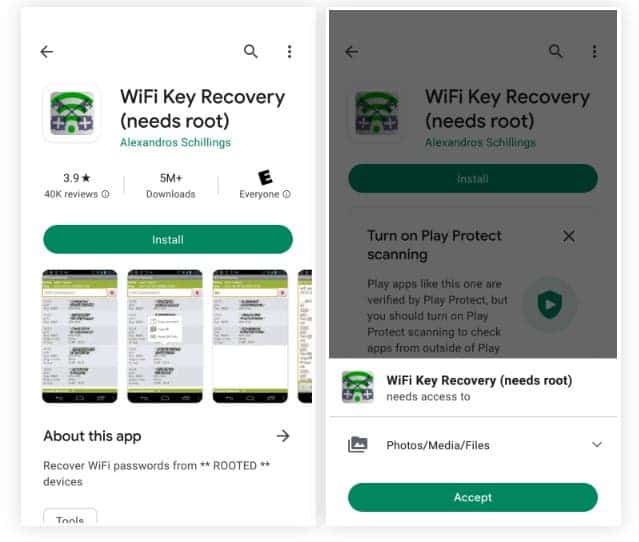
WiFi Password Viewer
Several apps on the Play Store claim to show your Wi-Fi passwords, but the only one we found to work on all of our devices was WiFi Password Viewer by Alexandros Schillings.
- Play Store Link: WiFi Key Recovery (needs root) (free)
When you first launch WiFi Key Recovery, the app will ask for Superuser access. Tap “Grant” on the pop-up, and it’ll take you to a list containing all of the Wi-Fi networks that you’ve ever connected to. Each entry shows a password beneath it. Use the search button to search for a particular WI-FI network if you have connected to multiple networks before.
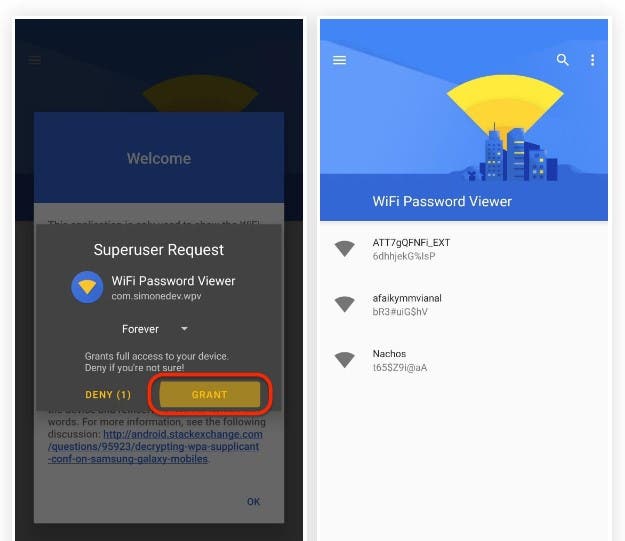
If you need to share one of these passwords with another device, you have a few options. Start by tapping any entry in the list, and a small menu will pop up. From here, you can either:
- Tap “Copy password” to copy that network’s password to your clipboard, which would make it easy to paste into your favorite texting app and send to the other device.
- Tap “Share,” then select your favorite texting app from the menu that appears to send the password.
- Tap “QR” to make the app generate a QR code containing the network info. If the other device has a built-in QR code scanner, open the camera or QR code scanner, point it at the QR code, and tap the pop-up prompt to automatically connect it to the Wi-Fi network.
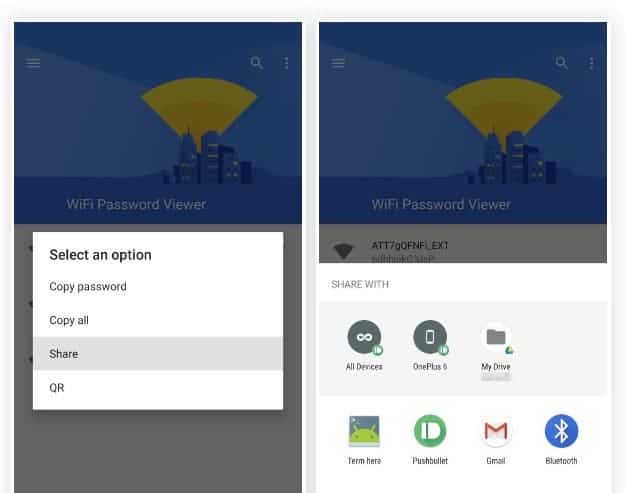
Conclusion
In conclusion, these methods cover various Android devices and versions, making it easy for you to find the Wi-Fi passwords saved on your device. Whether you have a stock Android device, a Samsung Galaxy, or a rooted device, you can use these techniques to view and share your saved Wi-Fi network passwords with ease.





